Hypercharger Market by Port Type (CCS, MCS, ChaoJi, NACS), Hypercharging Compatible Vehicle Sales by Vehicle Type (Passenger Cars, Light Commercial Vehicle and Heavy Commercial Vehicle), and Region - Global Forecast to 2030
[45 Page Report] The hypercharger market is projected to grow from 10.4 thousand units in 2023 to 273.7 thousand units by 2030, at a CAGR of 59.5%, during the forecast period 2023-2030. In the hypercharger market, Original Equipment Manufacturers (OEMs) and charge point operators are joining forces to build an extensive electric vehicle charging infrastructure. This collaboration encompasses the identification of suitable locations, installation and maintenance of charging points, and the facilitation of a smooth payment and user experience. Additionally, they are actively working on establishing universal standards and protocols to ensure seamless interoperability across diverse charging networks. The partnership between OEMs and charge point operators plays a pivotal role in facilitating the increasing presence of electric vehicles on roads and fostering global adoption.
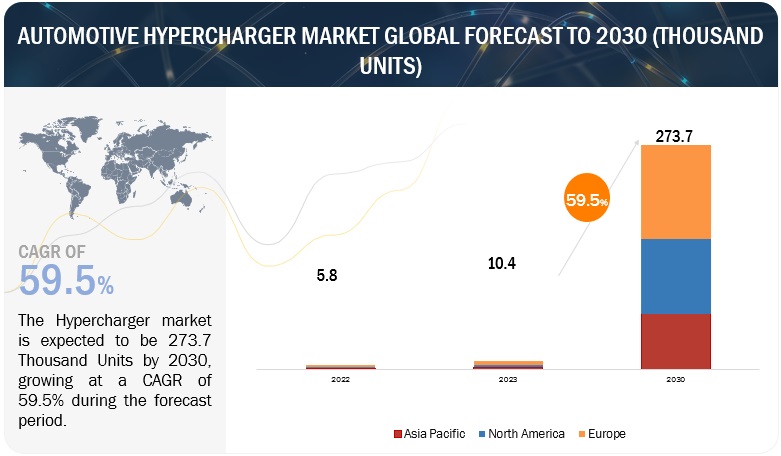
To know about the assumptions considered for the study, Request for Free Sample Report
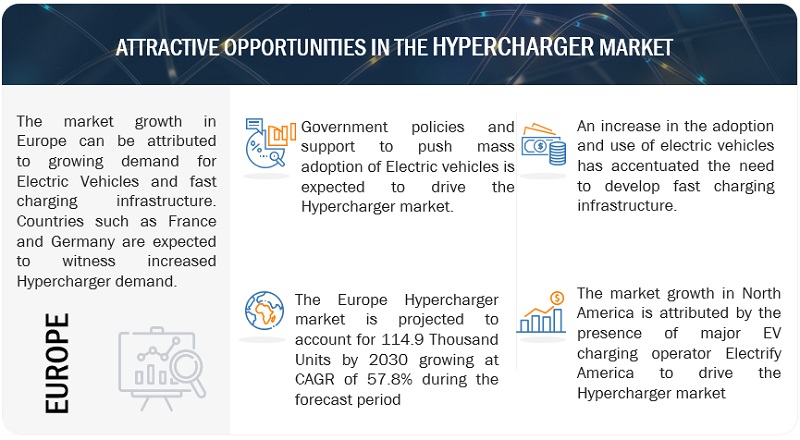
To know about the assumptions considered for the study, download the pdf brochure
Hypercharger (ultra-fast charging II) Market Dynamics:
Driver: Increase in adoption of Electric Vehicles
The hypercharger market is still in its early stages of development, but it is growing rapidly due to the increasing demand for EVs. Electric Vehicles (EVs) are rapidly gaining popularity as a sustainable transportation solution. However, range anxiety and inadequate charging infrastructure & speed remain top concerns. The availability and accessibility of EV charging stations along with the charging speed play a crucial role in the widespread adoption of EVs. Wider adoption towards EVs is increasing the demand for faster charging stations to meet the range standards of ICE vehicles, Global EV sales is expected to grow more than 3 times till 2030.
Restraint: DC Fast Chargers Can overload the grid
Power issues are one of the key restraints for the hypercharger market. DC fast chargers can overload the grid in some areas, which can lead to power outages and other disruptions. One solution to this problem is battery buffering. Battery buffering allows Hyperchargers to store energy when the grid is not under load and then use that energy to charge EVs when the grid is under load. This can help to reduce the strain on the grid and prevent power outages.
Opportunity: Electric Truck and Bus Segment witnessing Developments Towards Hyper Charging
The rapid advancements in Hypercharger technology for electric trucks and buses present a significant opportunity in the transportation industry. Innovations like Designwerk's megawatt charging system, Heliox's dedicated high-power charging, Scania and ABB's successful tests, and partnerships between Phihong Technology subsidiary Zerova, and CHARIN are pushing the boundaries of what's possible in terms of fast and efficient charging for electric commercial vehicles. As electric trucks and buses continue to gain traction, the development and commercialization of megawatt charging solutions will play a crucial role in accelerating their adoption and ensuring a sustainable future for transportation.
Challenge:Inadequate charging infrastructure in rural areas
The challenge in the hypercharger market lies in addressing the inadequate charging infrastructure in rural areas, limiting the accessibility of high-speed charging for electric vehicles in less densely populated regions. EV drivers may not have access to charging stations. Government can focus on integrating Hypercharger stations on highways and specific routes. This can help to promote the use of ultrafast charging stations. This can help to increase the demand for EVs, which will further drive the need for charging infrastructure.
Hypercharger Market Ecosystem
The ecosystem analysis highlights various players in the Hypercharger ecosystem, which is primarily represented by OEMs, charging station manufacturers, Energy Suppliers, End Users, Payment Processing Companies, Energy Management Companies, Navigation and Mapping Providers and Charging Station Operators. Prominent companies in this market as ABB (Switzerland), Electrify America (US), Heliox (Netherlands), Tritium (Australia) and IONITY (Germany) , etc.
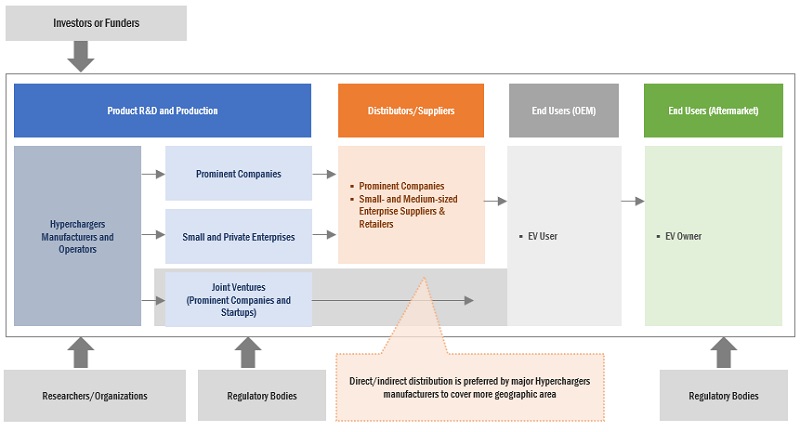
Heavy Commercial Vehicle segment to witness significant growth rate during the forecast period
Hypercharger compatible vehicle is set to see significant growth, particularly in the heavy commercial vehicle category. As the market for electric buses and trucks continues to rise, the imperative for rapid charging solutions becomes increasingly evident. Innovations like megawatt charging systems and dedicated high-power chargers are expected to drive the swift adoption of Hyper charging technology within the heavy commercial vehicle sector, catering to the distinctive needs of these sizeable, high-capacity electric vehicles.
Combined Charging System (CCS) segment is expected to be gain significant market share for Hypercharger market during the forecast period.
The Combined Charging System (CCS) segment is expected to gain a substantial market share in the rapidly evolving market. CCS stands out as an integrated and versatile charging standard, gaining prominence for its support of both alternating current (AC) and direct current (DC) charging. This adaptability positions CCS as the preferred choice for electric vehicle manufacturers, contributing to the expected increase in its market share. The widespread adoption of CCS reflects its compatibility and efficiency with several electric vehicle models, driving its significant presence in the market.
“Europe Hypercharger market is projected to hold the major market share by 2030.”
Germany, France, UK, Norway, Spain, Sweden, Spain and others have significant market in this region. France is the largest market for Hypercharger in the region. By the year 2030, Europe is expected to dominate the market, securing a substantial share. This projection underscores the region's anticipated leadership in the adoption and deployment of high-speed charging solutions for electric vehicles. As Europe continues to prioritize and invest in sustainable transportation infrastructure, the market is likely to see significant growth, making the region a key player in shaping the future of electric vehicle charging technology.
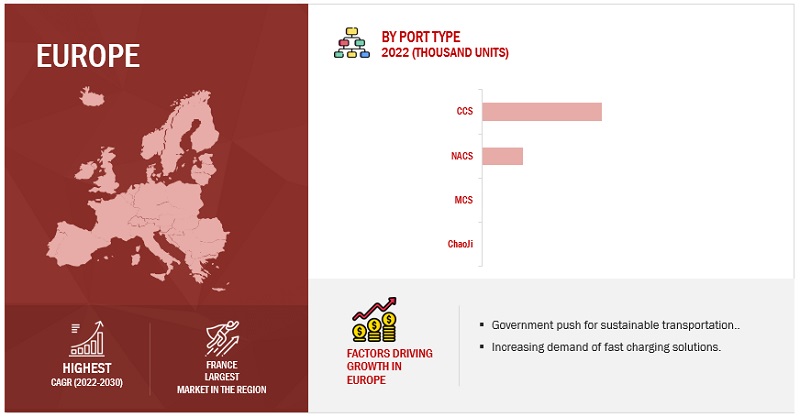
Key Market Players
The hypercharger market is dominated by a few globally established players such as ABB (Switzerland), Electrify America (US), Heliox (Netherlands), Tritium (Australia) and IONITY (Germany). The market is highly competitive with growing expansion by the regional players. These companies adopted strategies such as new product launches, deals and others to gain traction in the market.

Want to explore hidden markets that can drive new revenue in Hypercharger Market?
 Scope of the Report
Scope of the Report

Want to explore hidden markets that can drive new revenue in Hypercharger Market?

|
Report Metric |
Details |
|
Market size available for years |
2022–2030 |
|
Base year considered |
2022 |
|
Forecast period |
2023-2030 |
|
Forecast units |
Volume (Thousand Units) |
|
Segments covered |
Hypercharging Compatible Vehicle Sales by Vehicle Type, Port Type and Region |
|
Geographies covered |
Asia Pacific, North America, Europe |
|
Companies Covered |
ABB (Switzerland), Electrify America (US), Heliox (Netherlands), Tritium (Australia) and IONITY (Germany), etc |
This research report categorizes the hypercharger market based on Hypercharging Compatible Vehicle Sales by Vehicle Type, port type and Region.
Hypercharger Market, Hypercharging Compatible Vehicle Sales by Vehicle Type
- PC
- LCV
- HCV
Hypercharger Market, By Port Type
- NACS
- CCS
- CHAOJI
- MCS
Hypercharger Market, By Region
- North America
- Europe
- Asia Pacific
Recent Developments
- In 2021, ABB launched the world’s fastest EV charging station Terra 360, which can charge most EVs in less than 15 minutes.
- In 2022, CharIN introduces Megawatt Charging System (MCS) at EVS35, Oslo, with impressive demonstrations and upcoming product showcases.
- In June 2023, EVBox launches EVBox Troniq High Power, the most powerful standalone charging station with a 400 kW power output.
- In 2023, Electrify America plans to deploy a total of 10,000 350 kW chargers by 2025.
Frequently Asked Questions (FAQ):
What is the current size of the Hypercharger market?
The global Hypercharger market is estimated to be 5.8 Thousand Units in 2022 and projected to reach 273.7 Thousand Units by 2030.
Who are the winners in the Hypercharger market?
ABB (Switzerland), Electrify America (US), Heliox (Netherlands), Tritium (Australia) and IONITY (Germany), etc. These companies develop new products, adopt expansion strategies, and undertake collaborations, partnerships, and mergers & acquisitions to gain traction in the Hypercharger market.
What are the new market trends impacting the growth of the Hypercharger market?
One emerging market trend significantly impacting the growth of the Hypercharger market is the advent of Megawatt charging. Megawatt charging represents a substantial leap forward in electric vehicle charging technology, allowing for extremely fast charging rates. This innovation is crucial for addressing the needs of heavy-duty electric vehicles, such as trucks and buses, enabling them to recharge quickly and efficiently.
Which region is expected to be the largest market during the forecast period?
Europe
What is the total CAGR expected to be recorded for the Hypercharger market during 2022-2030?
The CAGR is expected to record a CAGR of 61.8% from 2022-2030.
To speak to our analyst for a discussion on the above findings, click Speak to Analyst

The study involved 4 major activities in estimating the current size of the hypercharger market. Exhaustive secondary research was done to collect information on the market, peer, and parent markets. The next step was to validate these findings, assumptions, and sizing with the industry experts across value chains through primary research. The top-down approach was employed to estimate the complete market size. Thereafter, market breakdown and data triangulation were used in estimating the market size of segments and subsegments.
Secondary Research
Secondary sources referred to for this research study include financial statements of companies offering Hypercharger and information from various trade, business, and professional associations. The secondary data was collected and analyzed to arrive at the overall size of the hypercharger market, which primary respondents validated.
Primary Research
Extensive primary research was conducted after obtaining information regarding the hypercharger market scenario through secondary research. Several primary interviews were conducted with market experts from both the demand and supply sides across major countries of North America, Europe, Asia Pacific. Primary data was collected through questionnaires, emails, and telephonic interviews. The primary sources from the supply side included various industry experts, such as Chief X Officers (CXOs), Vice Presidents (VPs), Directors, from business development, marketing, product development/innovation teams, and related key executives from Hypercharger station operators; system integrators; component providers; distributors; and key opinion leaders.
Primary interviews were conducted to gather insights such as market statistics, data of revenue collected from the products and services, market breakdowns, market size estimations, market forecasting, and data triangulation. Primary research also helped understand the various technology, application, vertical, and region trends. Stakeholders from the demand side, such as CIOs, CTOs, and CSOs, and installation teams of the customer/end users who are using Hypercharger stations were interviewed to understand the buyer’s perspective on the suppliers, products, component providers, and their current usage of Hypercharger stations and future outlook of their business which will affect the overall market.
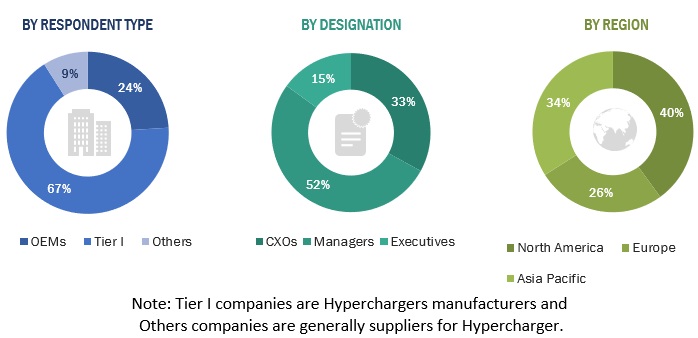
To know about the assumptions considered for the study, download the pdf brochure
Market Size Estimation
The bottom-up approach was used to estimate and validate the total size of the hypercharger market. These methods were also used extensively to estimate the size of various subsegments in the market. The research methodology used to estimate the market size includes the following:
- The key players in the industry and markets have been identified through extensive secondary research.
- The industry’s future supply chain and market size, in terms of volume, have been determined through primary and secondary research processes.
- All percentage shares, splits, and breakdowns have been determined using secondary sources and verified through primary sources.
Global Hypercharger Market Size: Bottom-Up Approach

To know about the assumptions considered for the study, Request for Free Sample Report
Data Triangulation
After arriving at the overall market size of the global market through the above-mentioned methodology, this market was split into several segments and subsegments. The data triangulation and market breakdown procedure were employed, wherever applicable, to complete the overall market engineering process and arrive at the exact market value data for the key segments and subsegments. The extrapolated market data was triangulated by studying various macro indicators and regional trends from both the demand- and supply-side participants.
Market Definition
Hyperchargers: Hyperchargers are defined as public EV Chargers with 350 kW and above power rating. As of 2023, few EVs are available, which are compatible with these chargers.
They are used mainly is luxury EVs and commercial vehicles including trucks, and require large battery capacity and specialized batteries to be charged at given charging speed. Currently, Hyperchargers are available with CCS, ChaoJi, MCS and NACS ports.
Key Stakeholders
- Associations, Forums, and Alliances related to Electric Vehicle Charging Stations
- Automobile Manufacturers
- Battery Distributors
- Battery Manufacturers
- Charging Infrastructure Providers
- Charging Service Providers
- Electric Utilities and Grid Operators
- Electrical Contractors
- Energy Storage Companies
- Environmental Groups
- EV Charging Network Operators
- EV Charging Pole Manufacturers
- EV Charging Station Service Providers
- EV Component Manufacturers
- EV Distributors and Retailers
- EV Manufacturers
- Government Agencies and Policymakers
- Oil & Gas Companies
- Property Owners
- Utility Companies
Report Objectives
- To segment and forecast the size of the hypercharger market in terms of volume.
- To segment and forecast the size of the global hypercharger market, by volume, based on Hypercharging Compatible Vehicle Sales by Vehicle Type (Passenger Cars, Light Commercial Vehicles and Heavy Commercial Vehicles)
- To segment and forecast the size of the global hypercharger market, by volume at based on Port type (CCS, MCS, ChaoJI, NACS)
- To segment and forecast the market size, by volume & value, based on region [Asia Pacific, Europe, North America]
Available Customizations
With the given market data, MarketsandMarkets offers customizations in accordance to the company’s specific needs.
- Hypercharger market, by Connection type, at a regional level
- Profiling of additional market players (Up to 5)














Growth opportunities and latent adjacency in Hypercharger Market